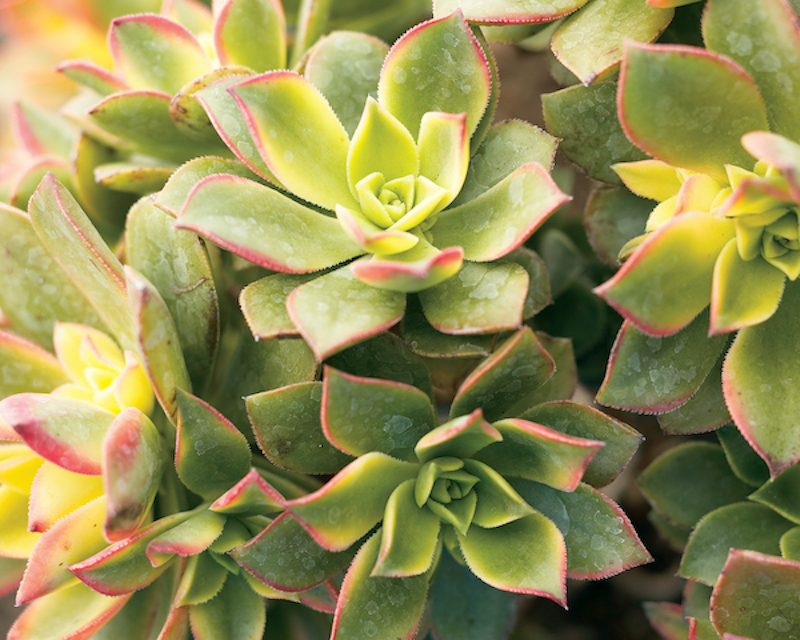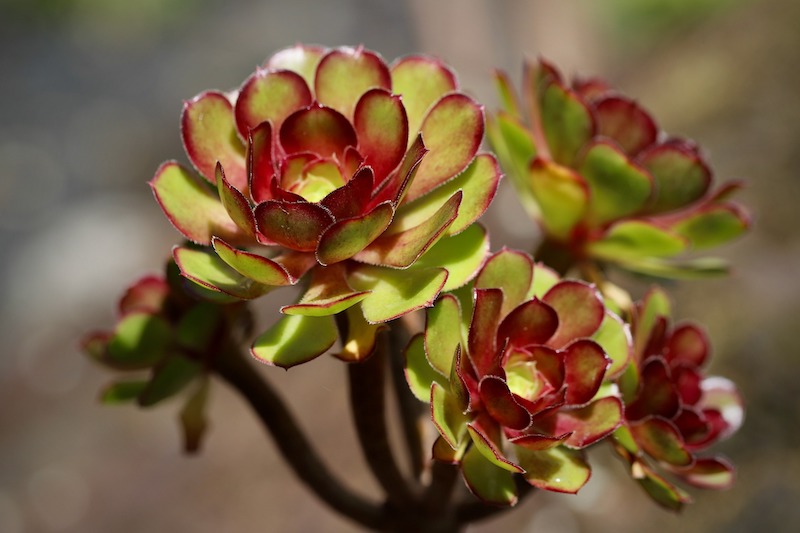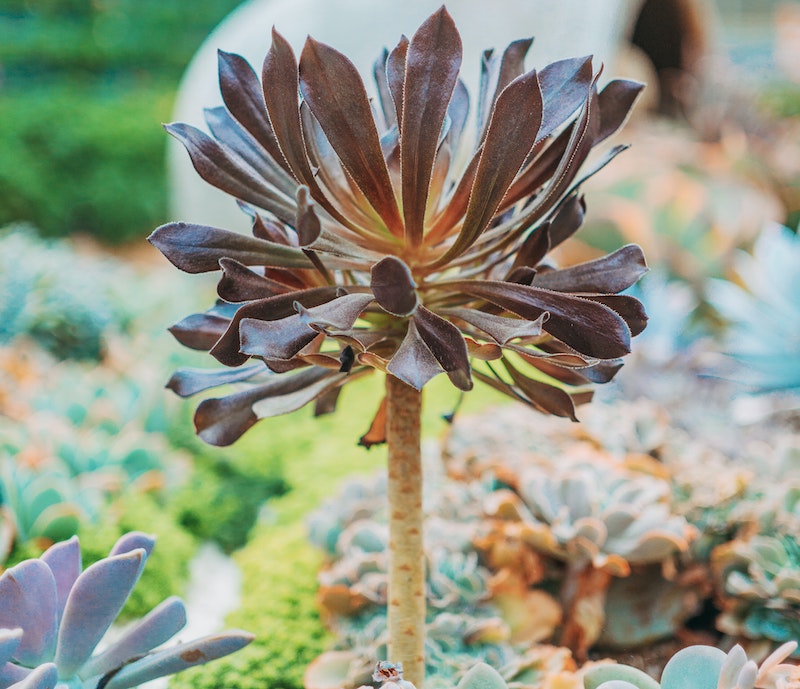Growing Aeonium
Aeonium is a large genus of plants native to tropical regions in Africa and the Canary Islands. Also called tree houseleeks, aeoniums are represented by several popular species, such as Aeonium arborescens and Aeonium decorum. These slow-growing, low-maintenance plants can grow from just a few inches tall to over 5 feet high. Aeoniums boast geometric rosettes of succulent leaves in variable colors, which can be green, tinged with red-purple, or variegated with creamy yellow.
Some aeoniums are tree or shrub-like, with rosettes formed at the end of long, woody stems. Others are low growing with a more mounding or spreading habit. Regardless of their form, aeoniums are easy indoor plants to care for.

Aeonium Sunlight Requirements
Aeonium requires bright indirect light. Set it near an east- or west-facing window to ensure it receives adequate sunlight. Avoid placing it near drafty windows, as prolonged exposure to chilly air will harm the plant. Aeonium does not grow well in low light conditions, which causes it to become leggy. Direct sunlight may be tolerated as long as the aeonium is properly acclimated to it. To acclimate it, situate the aeonium in a brighter location for approximately two hours a day. After a week, increase the duration by two hours for the next week. Continue until the aeonium is fully adjusted to the higher light conditions.
Planting Aeonium
Aeonium prefers well-drained soils that are slightly acidic, at about a pH of 6. Although it is a succulent, regular cacti potting mix drains too quickly and should not be used alone for aeonium. Choose a standard, peat-based growing medium, which will provide the lower pH and moisture retention needed for growing this plant. Mix in cacti soil. Use a ratio of one-third peat-based mix to two-thirds cacti mix. When potting aeonium, choose a pot that is just slightly larger than the root ball of the plant. Aeoniums are shallow-rooted and can handle pots that are wider than they are tall. Select a sturdy pot with drainage holes and plant the aeonium in it, using the soil mixture above. Aeonium tends to break easily when being handled, so be careful while planting it. Repot aeonium in the spring or fall during active growth. Repot every 2-3 years as needed.

Watering Aeonium
The shallow root system of aeoniums causes them to be more prone to underwatering than many other kinds of succulents. Water your aeonium about once a week during the growing seasons of winter and spring. Aeoniums should be watered about once or twice a month during the inactive growing period of summer. Irrigate whenever the soil feels dry and the leaves look wrinkled or wilted. Aeoniums do not tolerate dry soil for long periods of time, nor should their soil be saturated. Overwatering will result in root rot; do not let plants sit in overly moist soils, and take time to empty the drainage tray after each watering. Water less frequently if your home is particularly humid.
Fertilizing Aeonium
Aeonium can tolerate infertile soils without frequent fertilization. If desired, this plant can be fertilized just once in the spring with a well-balanced, slow-release granular fertilizer. Alternatively, a liquid fertilizer diluted to half strength per label recommendations can be used. Do not feed your aeonium during the dormant summer period. Over-fertilizing aeonium may lead to nutrient toxicity and death.
Common Aeonium Problems
Leaf drop is a common problem faced by aeonium. Luckily, it is usually due to natural causes, as aeoniums shed old leaves to favor new growth or to prepare for dormancy in summer. Occasionally, leaf drop can be a sign of stress due to improper watering or sudden changes in temperature. Be sure that your aeonium is watered appropriately and look out for common signs of water stress. Root rot and over-fertilizing are major causes of death for aeoniums. Additionally, aeonium is prone to pests such as mealybugs and spider mites. Treat these pests with neem oil per label instructions. Aeoniums are monocarpic, which means that they die soon after flowering. Some branching varieties of aeonium may just experience the death of the flowering stem. This is a normal process, which can be alleviated by planting propagules from the mother plant.
Propagating Aeonium
Spring is the best time for propagating aeonium. Low-growing aeoniums frequently produce offshoots, called pups, which are small, genetically identical plants growing from the base of the larger mother plant. These plants can be left to grow or carefully separated from the mother plant and replanted. Arborescent, or tree-like aeoniums can be propagated by stem cuttings. Cut just beneath the rosette of leaves, and allow the wound to scab over for 1-2 days. Plant the cutting in the soil mentioned above, and water infrequently until it has rooted. Gently tug the rosettes to check for roots; resistance will be met when the plants have sufficiently rooted. Arborescent aeoniums are prone to breakage from heavy rosettes. These broken stems can be propagated using the stem-cutting method.

Growing Aeonium Outdoors
Aeoniums are perennials in USDA zones 9-11. They can be placed outside in warm environments with full to partial sun exposure. Be sure to properly acclimate your aeonium to direct, outdoor light. In their native range, aeoniums experience active growth in winter to spring, going dormant by summer. This poses a challenge to gardeners in cooler climates, as the most growth will occur during the coldest months of the year. In these regions, aeoniums should be kept inside in summer and during long periods below 40°F. 60-75°F is the optimal temperature for aeonium. For aeoniums growing outside, water them enough to prevent them from completely drying out. Water less frequently if the aeoniums are planted in the ground or if the weather is particularly moist and humid.
 |
Lauren Youngcourt - Published 03-02-2023 |
